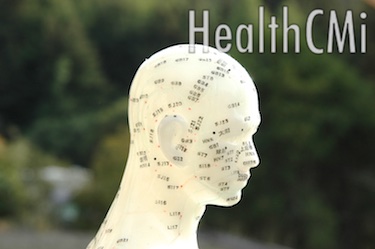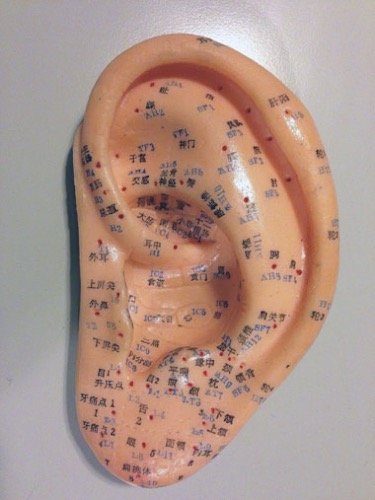Acupuncture improves hearing for patients with hearing loss. Research published in the International Journal of Clinical and Experimental Medicine finds acupuncture effective for the treatment of nerve related deafness. This type of sensorineural deafness is hearing loss due to auditory nerve damage.  The researchers, Jiang et al., conclude that acupuncture “can significantly improve the hearing of patients with nerve deafness, and the efficacy of acupuncture in combination with medication is superior to medication alone.”
The researchers, Jiang et al., conclude that acupuncture “can significantly improve the hearing of patients with nerve deafness, and the efficacy of acupuncture in combination with medication is superior to medication alone.”
Conventional medical treatments include cochlear implants, vasodilator medications, vitamin therapies, and steroids. In Traditional Chinese Medicine (TCM), both acupuncture and herbal medicines are used in the treatment of sensorineural hearing loss and deafness. The research finds acupuncture significantly more effective than medications. Acupuncture was also found more effective than than Er Long Zuo Ci Wan. This is a significant finding given that the herbal formula Er Long Zuo Ci Wan has been used in TCM for the treatment of hearing disorders for centuries and has also been found effective for the treatment of hearing related disorders in modern research.
Er Long Zuo Ci Wan contains the following herbal medicines:
- Magnetitum (Ci Shi)
- Radix Rehmanniae Preparata (Shu Di Huang)
- Fructus Corni Officinalis (Shan Zhu Yu)
- Cortex Moutan Radicis, Paeonia Suffruticosa (Mu Dan Pi)
- Rhizoma Dioscoreae Oppositae (Shan Yao)
- Sclerotium Poriae Cocos (Fu Ling)
- Rhizoma Alismatis Orientalis (Ze Xie)
- Radix Bupleuri Chinensis (Chai Hu)
Qiu et al. investigation the effects of Er Long Zuo Ci Wan and discovered that it reduces ototoxicity due to gentamicin consumption. Gentamicin is an antibiotic used in the treatment of gram-negative bacterial infections but has ototoxic and nephrotoxic properties. Qiu et al. also discovered that Er Long Zuo Ci Wan demonstrates protective effects on succinate dehydrogenase (SDH) in cochlear hair cells. Chen et al. note that hair cell loss correlates to hearing loss and SDH activity within cochlear hair cells and is a marker of cellular dysfunction and subsequent loss of auditory sensitivity. Together, these findings suggest that Er Long Zuo Ci Wan may have otoprotective properties. Additional research by Wang et al. suggests that Er Long Zuo Ci Wan may reduce chronic tinnitus.
The research points to the need for a comparison of the long and short-term effects of acupuncture and herbal medicine on hearing restoration. Jiang et al. find acupuncture able to prevent hearing loss to a greater degree than Er Long Zuo Ci Wan. Studies measuring the effects of acupuncture, Er Long Zuo Ci Wan, and acupuncture combined with Er Long Zuo Ci Wan over a period of several years are needed to determine the auditory effects over the long-term. 
Jiang et al. cite limitations to their acupuncture research. The researchers note that the small sample sizes of the 12 trials accepted into the meta-analysis limit the investigation. They add that additional studies are needed that make use of larger sample sizes. They add that the additional research will help to “verify the efficacy of acupuncture treatment of nerve deafness.” The researchers conclude, “the result of the meta-analysis shows that acupuncture may effectively improve the hearing conditions of patients with nerve deafness...”
In a related study, researchers conclude that acupuncture combined with ginger moxibustion benefits patients with tinnitus. Researchers applied acupuncture and ginger moxibustion to 34 patients with intractable tinnitus. The total therapeutic effective rate was 91.18%.
Acupuncture was applied to the following acupoints:
- TB17 (Yifeng)
- GB2 (Tinghui)
- SJ21 (Ermen)
- SI19 (Tinggong)
- LU7 (Lieque)
- GB43 (Xiaxi)
- SJ3 (Zhongzhu)
- LR3 (Taichong)
- GB40 (Qiuxu)
Reinforcing or reducing manual acupuncture techniques were applied to elicit a deqi sensation at the acupuncture points. Electroacupuncture was applied to the acupoints local to the the ears. Needle retention time was 30 minutes. Ginger moxibustion was applied during the acupuncture treatments. Treatment was administered daily for a 10 day period to comprise one course of care.
After a treatment time averaging 17 days, a total of 22 patients fully recovered, 5 patients showed marked improvements, 4 patients showed moderate improvements, and 3 patients had no improvements. Within four months after the acupuncture treatments, 27 patients experienced no worsening of symptoms or recurrence of symptoms. The researchers conclude that acupuncture plus ginger moxibustion have a significant curative effect on patients with intractable tinnitus.
References:
Jiang, Yuebo, Xian Shi, and Yan Tang. "Efficacy and safety of acupuncture therapy for nerve deafness: a meta-analysis of randomized controlled trials." Int J Clin Exp Med 8, no. 2 (2015): 2614-2620.
Li, Shilin, Yan Xiao, Yingli Song, and Jiang Wu. "Efficacy Observation of Acupuncture Combined with Ginger Moxibustion to Treatment of 34 Cases of Intractable Tinnitus." Zhongyi Zhongyao (Traditional Chinese Medicine and Herbs) Aug. 2013: 277-278.
QIU, Fang, Jie LIU, Song-jian KANG, Yong-zhi SHI, Xian-jun SHI, and Ying ZHANG. "The protective effects of modifier Erlongzuociwan on cochlear succinate dehydrogenase [J]." Chinese New Drugs Journal 11 (2004): 010.
Chen, Guang-Di, Misty L. McWilliams, and Laurence D. Fechter. "Succinate dehydrogenase (SDH) activity in hair cells: a correlate for permanent threshold elevations." Hearing research 145, no. 1 (2000): 91-100.
Wang, Y. M., H. Y. Song, Zhong Tong, S. J. Qian, R. X. Guo, Z. J. Jing, and J. R. Shi. "[Effects of er-long-zuo-ci-wan on the spontaneous activities of auditory central nucleus in rat model of tinnitus induced by salicylate acid]." Zhongguo ying yong sheng li xue za zhi= Zhongguo yingyong shenglixue zazhi= Chinese journal of applied physiology 25, no. 3 (2009): 397-401.


